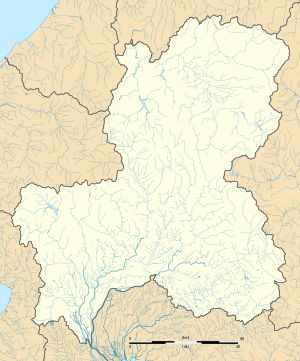Gifu Station
Gifu Station (岐阜駅, Gifu-eki) is a railway station in the heart of the city of Gifu, Gifu Prefecture, Japan, operated by Central Japan Railway Company (JR Central).
CA74 CG00 Gifu Station 岐阜駅 | |
|---|---|
Gifu Station | |
| Location | Hashimoto 1-chome, Gifu-shi, Gifu-ken 500-8856 Japan |
| Coordinates | 35.409514°N 136.75652°E |
| Operated by | |
| Line(s) | |
| Distance | 396.3 km from Tokyo |
| Platforms | 3 island platforms |
| Tracks | 6 |
| Other information | |
| Status | Staffed (Midori no Madoguchi) |
| Station code | CA74, CG00 |
| Website | Official website |
| History | |
| Opened | January 21, 1887 |
| Previous names | Kanō (until 1888) |
| Traffic | |
| Passengers (FY2016) | 31,742 daily |
| Location | |
 Gifu Station Location within Gifu Prefecture  Gifu Station Gifu Station (Japan) | |
Lines
Gifu Station is served by the JR Central Tōkaidō Main Line, and is located 396.3 kilometers from the official starting point of the line at Tokyo. It is also the terminal station for the Takayama Main Line. Along with Nishi-Gifu Station and Nagamori Station, it is one of the three JR Central stations in the city of Gifu.
Station layout
The station consists of three elevated island platforms serving six tracks for the Tōkaidō Main Line and Takayama Main Line, with the station building underneath. The station has a Midori no Madoguchi staffed ticket office.[1]
Platforms

| 1 | ■ Tōkaidō Main Line | for Nagoya and Okazaki (including limited express Shirasagi for Nagoya) limited express Shinano 9 from Osaka for Nagano extra rapid Moonlight Nagara for Tokyo |
| 2 | ■ Tōkaidō Main Line | for Nagoya and Okazaki (including limited express Hida for Nagoya) |
| 3 | ■ Takayama Line | for Mino-Ōta and Takayama |
| ■ Tōkaidō Main Line | for Nagoya and Okazaki (partly) | |
| 4 | ■ Takayama Line | for Mino-Ōta and Takayama limited express Hida for Mino-Ōta, Takayama and Toyama via the Takayama Line |
| ■ Tōkaidō Main Line | starting for Nagoya and Okazaki for Ōgaki and Maibara limited express Hida 36 for Ōsaka | |
| 5 | ■ Tōkaidō Main Line | for Ōgaki and Maibara starting for Nagoya and Okazaki |
| 6 | ■ Tōkaidō Main Line | for Ōgaki and Maibara |
Adjacent stations
| « | Service | » | ||
|---|---|---|---|---|
| Tōkaidō Main Line | ||||
| Kisogawa | Local | Nishi-Gifu | ||
| Owari-Ichinomiya | Semi Rapid Rapid New Rapid Special Rapid |
Nishi-Gifu | ||
| Owari-Ichinomiya | Home Liner | Hozumi | ||
| Takayama Main Line | ||||
| Terminus | Local | Nagamori | ||
History

The station first opened on January 21, 1887, named Kanō Station (加納駅) and was primarily used for the transport of goods. On December 15, 1888, it became a passenger rail station, at which point its name was changed to Gifu Station. On July 22, 1913, the former Aichi Station building, which closed in 1909, was moved to the area that is now the south side of Gifu Station. This station was used until it was burned to the ground during the firebombings of Gifu City in 1945. On April 1, 1987, it became part of JR Central. On November 1, 1986, construction of the elevated rail lines began, with construction ending on March 2, 1996. The station was extensively remodelled in 2008.
Passenger statistics
In fiscal 2016, the station was used by an average of 31,742 passengers daily (boarding passengers only).[2]
Surrounding area
Bus services
On the north side of JR Gifu Station are bus boarding platforms for all of the bus lines belonging to Gifu Bus, Co., Ltd. There are 15 bus boarding platforms in all, with 12 serving bus lines to different parts of Gifu and its surrounding municipalities. The first two platforms are only for alighting and the last one is currently not being used.[3]
See also
References
- JR Central Gifu Station information. JR Central. Accessed December 5, 2007. Archived November 17, 2007, at the Wayback Machine
- 岐阜県統計書(平成28年) [Gifu Prefecture Statistics (Fiscal 2016)] (PDF) (in Japanese). Japan: Gifu Prefecture. 2017. Retrieved 11 October 2017.
- Gifu Bus Platform Guide Archived 2008-09-14 at the Wayback Machine. Gifu Bus., Co., Ltd. Accessed December 5, 2007.